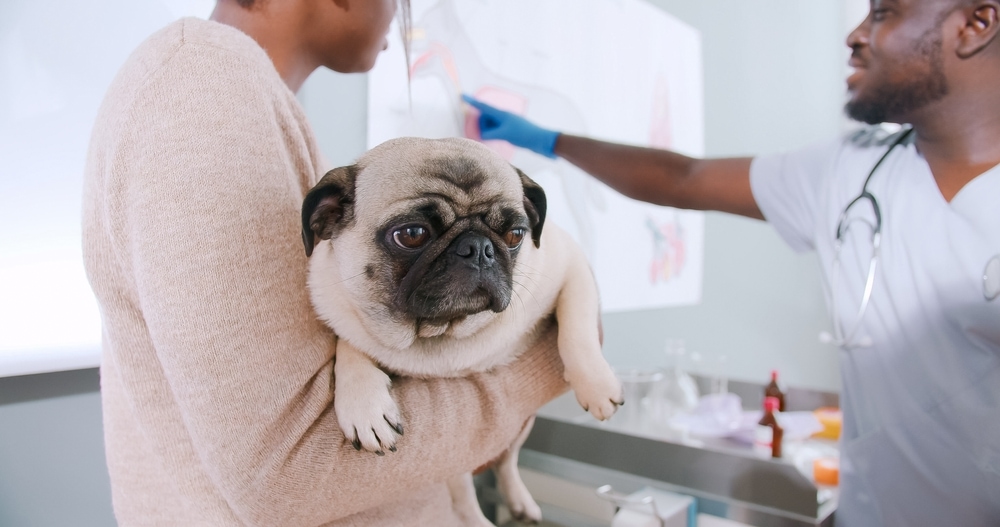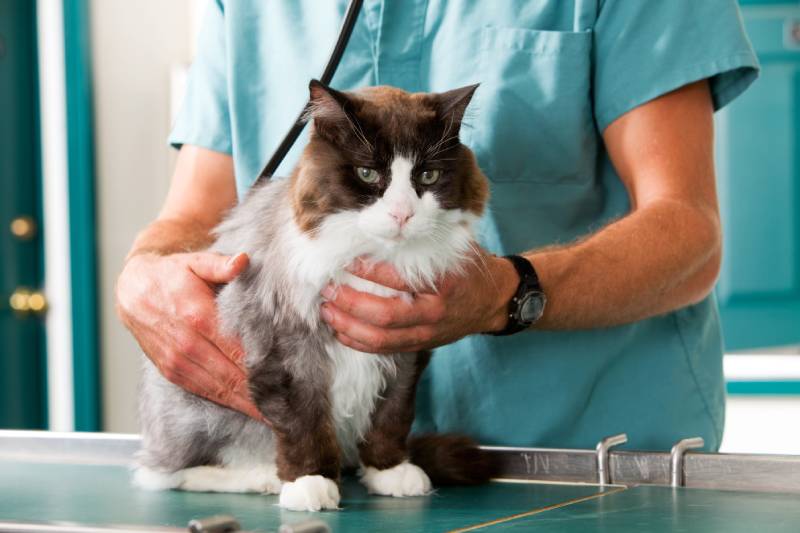Encephalitis in Pugs: Causes, Signs, Care & FAQ (Vet Answer)
Updated on

Click to Skip Ahead
Encephalitis is defined as inflammation of the brain. As the brain is the control center for the whole body, encephalitis causes neurological signs such as seizures, tremors, and wobbliness. Unfortunately, Pugs are more commonly affected by this condition than other breeds, and it can be very difficult to treat. While encephalitis sometimes has an identifiable cause, such as infection with bacteria, it is usually an auto-immune condition. This means the body has an abnormal immune response to its own brain tissue.
When you search the internet for “encephalitis in dogs”, there are lots of different forms of this disease. Additionally, the signs of disease can be vague and variable. This article will answer all your questions about encephalitis in Pugs.
What is Encephalitis in Pugs?
Here, it helps to start with some definitions. Encephalitis in dogs is commonly referred to in veterinary circles as MUO—meningoencephalitis of unknown origin. The meninges are the thin layers of tissue that encase the brain, so MUO refers to a condition in which the brain, as well as its “casing” and surrounding fluid, have become inflamed.
Just to confuse things, MUO is an umbrella term, meaning that this one term is often used to describe four specific types of encephalitis.
- Necrotizing meningoencephalitis. This is the type of encephalitis that most commonly affects Pugs, and, therefore, it is the focus of this article. You might see it referred to as PDE, which stands for “Pug Dog Encephalitis”.
- Granulomatous meningoencephalitis.
- Greyhound meningoencephalitis.
- Necrotizing leukoencephalitis.
For now, we can forget about the last three forms of encephalitis and focus on the necrotizing meningoencephalitis that affects Pugs.

What Are the Signs of Encephalitis in Pugs?
There are multiple regions of the brain, and the signs of encephalitis depend on which region is affected by inflammation. Generally, the signs of encephalitis include:
- Seizures
- Muscle tremors
- Blindness
- Head tilt
- Walking in circles
- Abnormal or dull behavior
- Wobbliness or weakness
- Severity of signs: Some dogs will only exhibit one or two of these signs, whereas other dogs will show most of the signs.
- Progression of signs: The progression of signs varies from dog to dog. Some dogs develop signs quite suddenly, but other dogs develop signs slowly, over a few months.
- Age of onset: Most Pugs affected by encephalitis are relatively young, developing this disease between 6 months and 6 years of age.
What Are the Causes of Encephalitis in Pugs?
The cause of encephalitis in Pugs remains largely unknown. Although some forms of encephalitis are infectious, meaning bacteria, viruses, or parasites are responsible, necrotizing meningoencephalitis is considered an auto-immune disease. The dog’s immune system mistakenly identifies its own brain tissue as abnormal and thus sends white blood cells there. This results in damage to neurons, the cells that make the brain work, resulting in either dead neurons, holes in the brain tissue (“cavitation”), or both.
In Pugs, studies have shown that genes likely play a role. Inbreeding may be responsible for some dogs inheriting genes that predispose them to encephalitis.
How Do I Care for a Pug with Encephalitis?
Caring for a Pug with encephalitis starts with a consultation with your veterinarian. The veterinarian will perform a physical examination and some early diagnostic tests. They may refer you to a specialist veterinary neurologist, or you may decide to do a “treatment trial”.
Treatment for encephalitis in Pugs aims to reduce the inflammation and abnormal immune response. The medications that are used are referred to as “immunosuppressants”, as they suppress the immune system. Prednisone, a corticosteroid, is the most common medication and is relatively affordable. Depending on the dog’s response to this treatment, other immune-suppressive medications such as azathioprine and cyclosporine might be considered.
There are no home remedies or easy fixes for encephalitis in Pugs. Alternative and holistic therapies can be considered alongside regular immunosuppression, though research supporting these treatments is currently lacking.

Frequently Asked Questions
How is Encephalitis in Pugs Diagnosed?
After performing a physical examination, most vets will perform routine blood tests to assess internal organ function. Next, infectious disease testing might be performed to rule out bacterial, viral, and parasitic causes of encephalitis. If all of these tests return normal results, your vet may refer you to a specialist neurologist.
Generally, the next step involves a general anesthetic for CSF and MRI testing. CSF analysis involves collecting a sample of CSF (cerebrospinal fluid) and looking under the microscope for the presence of inflammatory cells. MRI (magnetic resonance imaging) is used to generate a three-dimensional image of the brain and look for structural changes, such as the cavitation that was previously described. In dogs, these procedures are performed under general anesthetic as the patient must remain very still for a long period of time.
What is the Prognosis for Pugs with Encephalitis?
Unfortunately, the prognosis for Pugs with encephalitis is poor. Some dogs respond temporarily to treatment, but most dogs eventually succumb to this disease. The average survival time for Pugs with encephalitis is around 3 months. Dogs that undergo treatment will usually live longer than dogs receiving no treatment. It is important to note that this number is an average, and there is significant variation: some dogs live for weeks, and other dogs for up to a year.
Conclusion
Encephalitis in Pugs is a serious neurological disease. While there are multiple types of canine encephalitis, broadly termed MUO, Pug dogs are usually affected by necrotizing meningoencephalitis. In this condition, inflammation of the brain due to genetic and auto-immune factors causes seizures, wobbliness, blindness, and changes in behavior. Treatment can be implemented, though the response is variable.
If your Pug is showing any of the above signs, or if you’d like to discuss this condition with a professional, don’t hesitate to contact your veterinarian.
Featured Image Credit: charlesdeluvio, Unsplash














